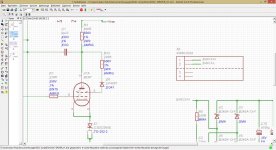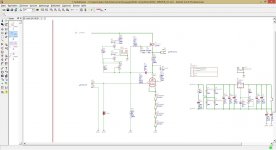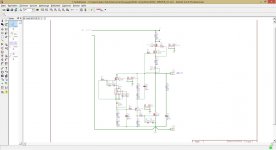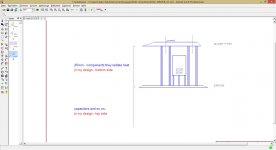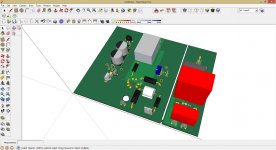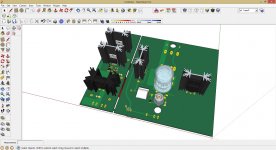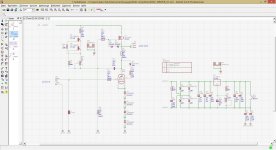many thanks Magz!
Magz: I´m very interested about the temperature in the case
The hottest part of the chassis (the heat sink where the IRFP450 mosfet from the shunt regulator is attached) gets to 60C or so after several hours of running. The top plate gets to about 60C near the heat sink for the filament regulators. The fan keeps cool air coming in from the back of the amp to the front. Been running it almost a year now and no heat-related problems yet - I just had them open two weeks ago to add in some protection diodes around the regulator MOSFETs and no sign of any heat-related stress inside, in fact they looked like the day I closed them up, nice and clean.
I strapped the 6E5P screen grid to the plate using a 200R resistor plus a
UF4007 diode (cathode away from the plate).
I haven't seen a screen connected this way before.. Does the diode make it basically a DC supply, so it's pentode-like. But super easy way to get a screen voltage?
I haven't seen a screen connected this way before.. Does the diode make it basically a DC supply, so it's pentode-like. But super easy way to get a screen voltage?
Nah, it's a controversial subject...some swear it sounds better with the diode there because it prevents plate currents from interacting with the screen grid; others say it makes no difference whatsoever from an engineering perspective. I put it in because someone whose opinion I respect said he hears an improvement that way.
Here's a discussion on the subject:
Screen diodes - better explanation - Goneill - DIY HiFi Forum
The money line:
In the case of connecting a Tetrode or Pentode as a Triode, by strapping the Screen Grid to the Plate, the valve behaves as a Triode. Inserting the Diode as described has a similar effect on the electron/current flow but the sound will still remain the "triode" sound - albeit it cleaner and brighter.
.
Last edited:
... this way?
No the opposite way. Cathode toward the screen. I'd also make sure that the resistor is right next to the screen connection.
Last edited:
Also, if you're going to build this I'd consider a power transformer other than the Hammond 733A. Although it works fine for me it does hum a little - I put rubber sheeting under it, soundcoat on the end bells and a cover over it and that reduced it to inaudible from more than a foot or so away, but better not to have hum at all. With the cost of the Hammond plus shipping from North America, you may be better off asking Monolith to make you a nice potted power transformer specific for the application - shipping should be much cheaper for you being in Germany than it was for me in the US.
Just a thought.
Just a thought.
... not really a big progress!!!
What do you think about puting the 833C tube with fan in an own case?
High voltage connection with LEMO ERA (or SubD high voltage contacts) and heating supply with power connector?
What do you think about puting the 833C tube with fan in an own case?
High voltage connection with LEMO ERA (or SubD high voltage contacts) and heating supply with power connector?
Attachments
... sorry but busy with the development of a emergency erasable USB stick!
as promised...
It's very hard for me to read those schematics, but why do you have zener diodes where the MOSFETs are supposed to be in the voltage reference for the AOT2N60?
.
Last edited:
... not really a big progress!!!
What do you think about puting the 833C tube with fan in an own case?
High voltage connection with LEMO ERA (or SubD high voltage contacts) and heating supply with power connector?
There are no doubt many ways to skin this cat. You will have to decide what works best for you. I preferred to keep all the ultra-high voltages in the same chassis as close as possible together; you may feel differently.
Whatever you do, be VERY CAREFUL! These voltages will kill you very easily.
they are switchable current regulators and the many peoples use this symbol!
correction done!
An externally hosted image should be here but it was not working when we last tested it.
correction done!
Attachments
I've been playing around with the AC voltage at which I run the amps, using the P5 regenerators. Turns out that the amps really like to run at 110V instead of the 117V I was running them at previously; the cathode regulator was adjusted to a bias current of 150mA. The big Hammond power transformer is quieter there, the filament supply chokes are as well. From the listening chair the only sound at zero volume is the very slight rush of air around the 833C tubes. The heat sink for the bias MOSFET runs a couple degrees cooler, too. Plate voltage on the 833s drops from 2.3kV to 2.1kV, and max output power drops to about 170W from 200W, but I never need the full 200W anyway.
The sound with the volume up is a little more relaxed, with nice detailed bass and lots of air. Everything just seems happier and less stressed at the lower AC voltage. I think it will stay there...
The sound with the volume up is a little more relaxed, with nice detailed bass and lots of air. Everything just seems happier and less stressed at the lower AC voltage. I think it will stay there...
I've been playing around with the Speltz Zero Autoformers between the Midlife Crisis amps and my Infinity RSIIb speakers, trying different impedance multiplication factors. The Zeros are capable of multiplying speaker impedance by 2X, 3X or 4X; at 1kHz that translates to 6.5, 9.5 and 13 ohm impedance for my RSIIb's.
Spice shows that max power from the 4ohm tap at each setting is 135W at 2X, 100W at 3X and 70W at 4X. Damping factor becomes a whopping 11 at the 4X setting (well whopping for an SET on these speakers, anyway...).
I'm liking the 4X setting - it gives tighter bass, and seems to even out the overall frequency response as well. It even adds a bit of extra detail into the sonic picture. An advantage of having lots of power is that even running from the 4ohm tap into a 13ohm load I still have 70W of power available. That's enough to play louder than my normal listening for sure.
So far the verdict is that the Zeros are pretty useful, and I don't detect a sonic penalty from their insertion, in fact things sound a bit clearer and fuller instead. Just thought I'd share.
Spice shows that max power from the 4ohm tap at each setting is 135W at 2X, 100W at 3X and 70W at 4X. Damping factor becomes a whopping 11 at the 4X setting (well whopping for an SET on these speakers, anyway...).
I'm liking the 4X setting - it gives tighter bass, and seems to even out the overall frequency response as well. It even adds a bit of extra detail into the sonic picture. An advantage of having lots of power is that even running from the 4ohm tap into a 13ohm load I still have 70W of power available. That's enough to play louder than my normal listening for sure.
So far the verdict is that the Zeros are pretty useful, and I don't detect a sonic penalty from their insertion, in fact things sound a bit clearer and fuller instead. Just thought I'd share.
Last edited:
PS: Not saying I'll be running the amps 4ohm into 13 ohm for long, though. These OPTs are too expensive to risk frying with too high a voltage, but the experiment is interesting...
PPS: I have a 6kV gas discharge tube across the primary of the OPT, so even a gross overvoltage s.a. a flyback spike will probably be taken care of safely. Another day of listening confirms that these amps really like the Zeros for these speakers...it'll be tough to remove them I think... ;-)
Magz,
What model are the speakers in this picture:
833AmpwithSpeakers_zps49e503bc.jpg Photo by Quagmire22 | Photobucket
What model are the speakers in this picture:
833AmpwithSpeakers_zps49e503bc.jpg Photo by Quagmire22 | Photobucket
Infinity RSIIb, circa 1985.
I've completely rebuilt them with an external passive crossover, extra internal bracing, Cardas copper litz wiring, a totally re-done low frequency EQ unit (only things stock are the box and the knobs), and new midrange ribbon diaphragms (yes, true ribbons!) from Apogee Acoustics.
I've completely rebuilt them with an external passive crossover, extra internal bracing, Cardas copper litz wiring, a totally re-done low frequency EQ unit (only things stock are the box and the knobs), and new midrange ribbon diaphragms (yes, true ribbons!) from Apogee Acoustics.
- Home
- Amplifiers
- Tubes / Valves
- The Midlife Crisis - My 833C Amp Build
